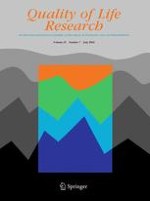01-07-2016
Health-related quality of life questionnaire for polycystic ovary syndrome (PCOSQ-50): development and psychometric properties
Gepubliceerd in: Quality of Life Research | Uitgave 7/2016
Log in om toegang te krijgenAbstract
Purpose
The determinants of the health-related quality of life of women with polycystic ovary syndrome are not fully understood. The aim of this study was to develop a comprehensive instrument to assess the health-related quality of life of Iranian women with PCOS and to assess its psychometric properties.
Methods
We used a mixed-method, sequential, exploratory design including both qualitative [in-depth interview to define the components of health-related quality of life questionnaire (PCOSQ)] and quantitative approaches (to assess the psychometric properties of PCOSQ).
Results
A preliminary questionnaire was developed including 147 items which emerged from the qualitative phase of the study. Considering the optimum cutoff points for content validity ratio (CVR), content validity index (CVI), and impact score, items of the preliminary questionnaire were reduced from 147 to 88 items. Finally, by excluding highly correlated items using the exploratory factor analysis, a 50-item questionnaire was obtained. The Kaiser criteria (eigenvalues >1) and Scree plot tests demonstrated that six factors were optimum with an estimated 47.3 % of variance. Assessment of the psychometric properties of the questionnaire demonstrated a mean CVI = 0.92, CVR = 0.91, Cronbach’s alpha for whole questionnaire = 0.88 (0.61–0.88 for subscales), Spearman’s correlation coefficients of test–retest = 0.75, and the intra-class correlation coefficient for the PCOS questionnaire subscales ranging from 0.57 to 0.88. Eventually the final questionnaire included 50 items in six domains, ‘psychosocial and emotional,’ ‘fertility,’ ‘sexual function,’ ‘obesity and menstrual disorders,’ ‘hirsutism,’ and ‘coping’ and rated on a 5-point Likert scale.
Conclusion
The PCOSQ-50 is a valid and reliable instrument for the assessment of quality of life of women with PCOS, capable of assessing some obscure aspects overlooked by previous HRQL questionnaires.
